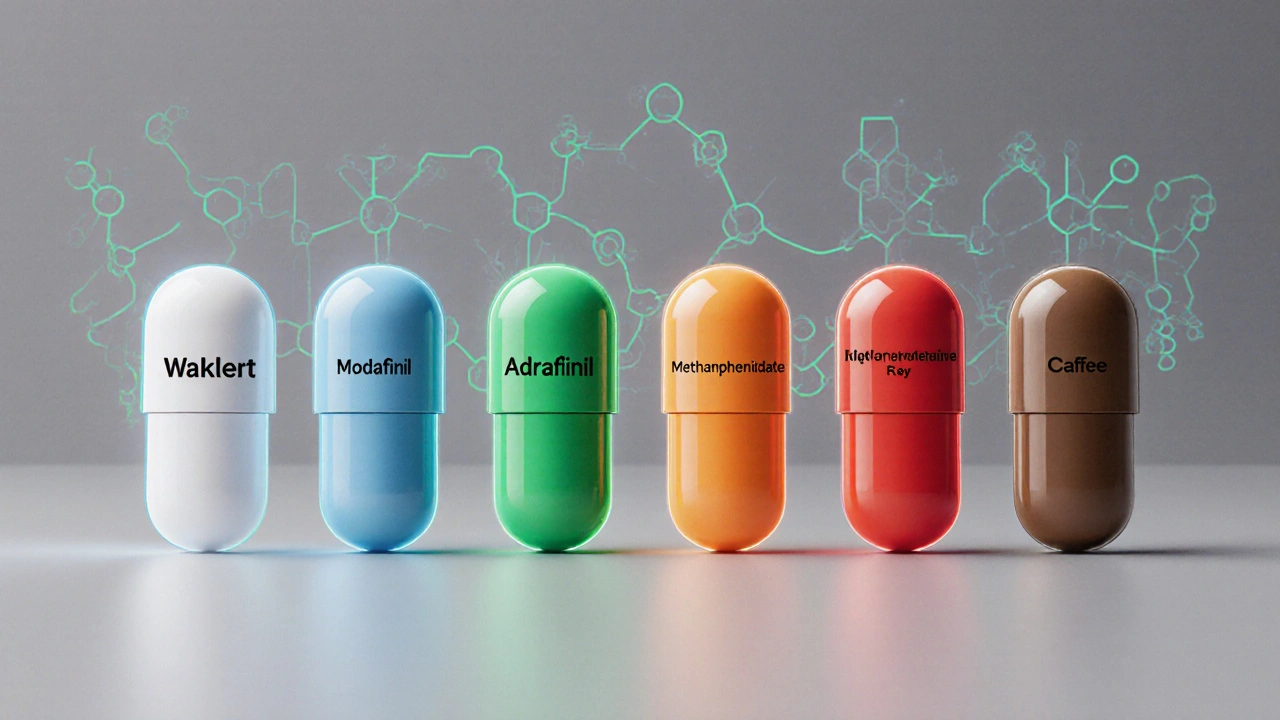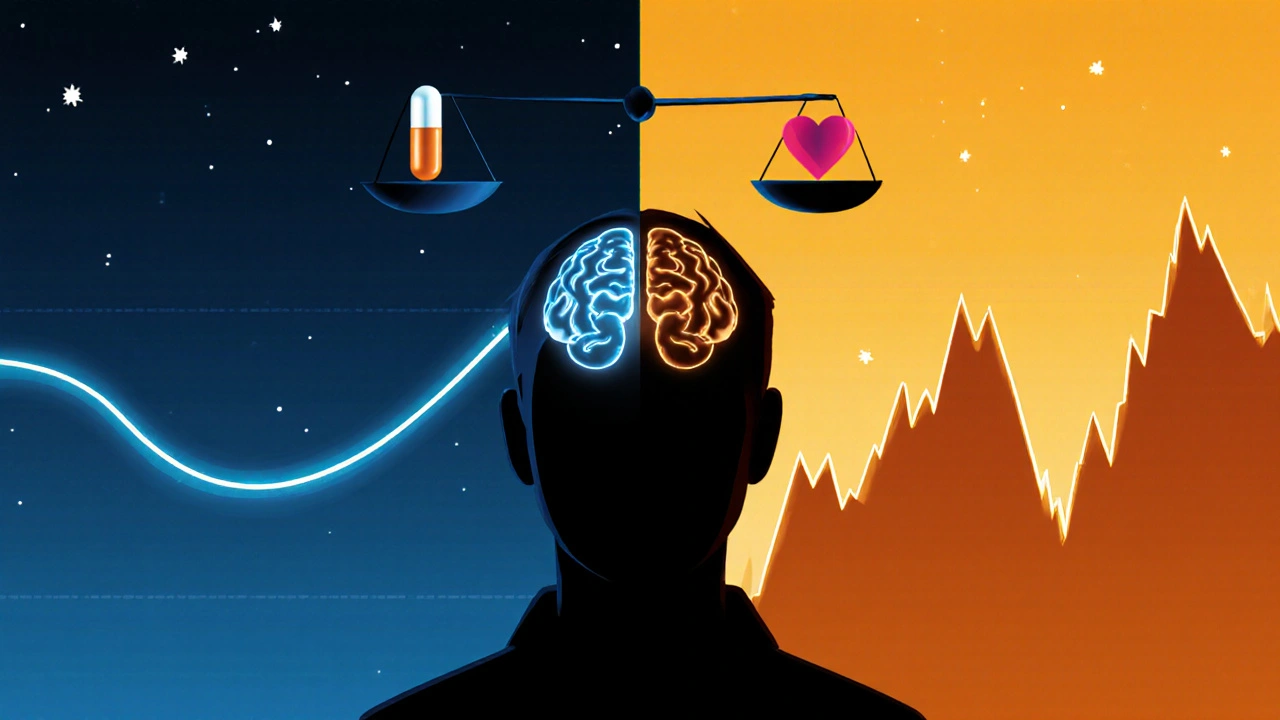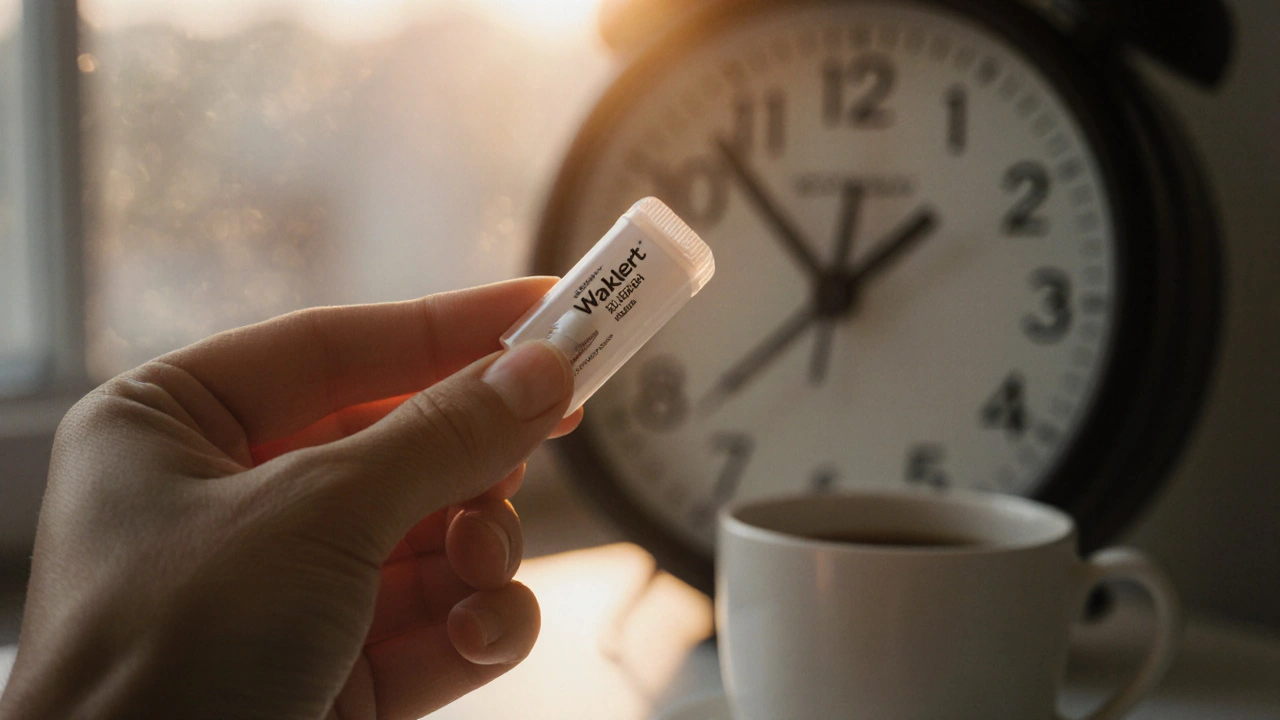Waklert vs Alternatives: Drug Selector
Key Takeaways
- Waklert (armodafinil) offers a longer half‑life and smoother onset than most off‑label options.
- Modafinil is cheaper but may cause more noticeable peaks and troughs.
- Adrafinil works as a pro‑drug for modafinil but carries liver‑stress risks.
- Stimulants such as methylphenidate and dextroamphetamine deliver stronger wakefulness but bring higher abuse potential.
- Choosing the right agent depends on your condition, dosage flexibility, side‑effect tolerance, and legal status.
When looking for a wake‑up aid, Waklert is the brand name for armodafinil, a prescription medication that promotes alertness. It’s popular among people with narcolepsy, shift‑work sleep disorder, and those pursuing cognitive enhancement. But the market is crowded with alternatives that differ in chemistry, cost, and safety. Below you’ll find a side‑by‑side comparison that cuts through the hype.
What is Waklert (Armodafinil)?
Armodafinil is the R‑enantiomer of modafinil, meaning it contains only the active half of the molecule. This results in a half‑life of about 15hours, compared with roughly 12hours for regular modafinil. The longer duration translates to steadier plasma levels, which many users describe as a “smooth” boost without the jittery spikes seen with classic stimulants.
Typical dosing for adult patients is 150mg taken once daily in the morning. Because it’s a ScheduleIV drug in the United States, it requires a physician’s prescription and is regulated in most other countries.
Common Alternatives at a Glance
Below are the most frequently mentioned wakefulness agents:
- Modafinil is a non‑amphetamine wake‑promoting medication approved for narcolepsy and shift‑work sleep disorder.
- Adrafinil is an over‑the‑counter pro‑drug that the body converts into modafinil.
- Methylphenidate (commonly known as Ritalin) is a stimulant used for ADHD that also boosts alertness.
- Dextroamphetamine (Dexedrine) is a potent amphetamine that increases dopamine and norepinephrine release.
- Caffeine is the world’s most widely consumed psychoactive substance, found in coffee, tea, and pills.

How to Compare Wake‑Promoting Drugs
To make an informed decision, look at these core criteria:
- Mechanism of action: How the drug triggers wakefulness.
- Onset and duration: How fast you feel the effects and how long they last.
- Typical dosage: Strength per pill and flexibility for titration.
- Side‑effect profile: Common adverse events and long‑term concerns.
- Legal status & prescription requirement: Whether you need a doctor’s order.
- Cost per month: Average retail price in USD and availability.
Side‑by‑Side Comparison Table
| Drug | Mechanism | Onset | Half‑Life | Typical Dose | Common Side‑Effects | Prescription? | Average Monthly Cost (USD) |
|---|---|---|---|---|---|---|---|
| Waklert (Armodafinil) | Selective dopamine reuptake inhibition | 30‑60min | ≈15h | 150mg once daily | Headache, mild insomnia | Yes | $90‑$130 |
| Modafinil | DAT inhibition, indirect orexin activation | 45‑90min | ≈12h | 200mg once daily | Dry mouth, anxiety | Yes | $60‑$100 |
| Adrafinil | Pro‑drug converted to modafinil in liver | 60‑120min | ≈12h (after conversion) | 300‑600mg once daily | Liver enzyme elevation, nausea | No (OTC in some regions) | $30‑$50 |
| Methylphenidate | Blocks dopamine and norepinephrine reuptake | 15‑30min | ≈3‑4h | 10‑30mg 2‑3× daily | Appetite loss, jitteriness | Yes | $40‑$80 |
| Dextroamphetamine | Promotes release of dopamine & norepinephrine | 20‑40min | ≈10‑12h | 5‑20mg 1‑2× daily | Cardiovascular stress, insomnia | Yes | $70‑$120 |
| Caffeine | Adenosine receptor antagonist | 5‑15min | ≈5h | 100‑200mg (cup of coffee) | Rapid heartbeat, digestive upset | No | Negligible |
Best Use Cases for Each Option
Narcolepsy is a neurological disorder characterized by uncontrollable daytime sleep attacks. Clinical guidelines often favor armodafinil or modafinil because they provide consistent wakefulness without the high abuse potential of amphetamines. If you need a once‑daily pill that lasts through a full work shift, Waklert usually wins.
Shift Work Sleep Disorder is a condition where irregular work hours disrupt natural circadian rhythms. Here, cost‑sensitive users may pick generic modafinil, while those who experience “crash” after the drug wears off might opt for dextroamphetamine for its longer tail.
For students or professionals chasing a short burst of focus, caffeine or a low‑dose methylphenidate regimen can be enough. However, the risk of tolerance builds quickly, so rotating with a non‑stimulant like adrafinil (if liver health is monitored) can keep the edge.

Safety, Tolerability, and Legal Landscape
All prescription wake‑promoting agents share a black‑box warning for potential psychiatric effects. Armodafinil has been shown in trials to cause less severe mood swings than amphetamines, but users should still watch for insomnia if taken too late in the day.
Adrafinil’s main drawback is hepatic strain; regular liver function tests are advised. Amphetamines (methylphenidate, dextroamphetamine) carry higher cardiovascular warnings and are classified as ScheduleII in many jurisdictions, meaning stricter prescribing limits.
Caffeine is legal worldwide and considered safe in moderate amounts, yet high intake can lead to dependency and rebound fatigue.
How to Choose the Right Option for You
Answer these questions before you decide:
- Do you have a diagnosed sleep disorder (narcolepsy, SWSD) that requires a prescription?
- Is cost a primary concern, or are you willing to pay more for smoother effects?
- Do you have any liver, heart, or psychiatric conditions that rule out certain drugs?
- How many hours of alertness do you need each day?
- Are you comfortable managing a prescription and periodic lab tests?
If you answered “yes” to #1 and #5, a prescription route (Waklert or modafinil) is logical. If #2 and #3 point to budget and liver health, adrafinil might be a temporary bridge, but monitor labs. For short‑term boosts without doctor visits, caffeine is the safest fallback, but expect a quicker crash.
Next Steps and Practical Tips
- Consult a sleep specialist to get a formal diagnosis; many insurers cover the visit.
- Ask your doctor about starting with the lowest effective dose of armodafinil (usually 150mg).
- If you try adrafinil, schedule a liver panel every 2‑3months.
- Track your sleep quality with a simple app; note any insomnia or daytime jitter.
- Never combine multiple stimulants without medical supervision.
Frequently Asked Questions
Is Waklert stronger than Modafinil?
Armodafinil (Waklert) contains only the active R‑enantiomer, which gives a longer half‑life and steadier blood levels. In practice, many users feel the effect is smoother, but “stronger” depends on the individual’s metabolism.
Can I buy Adrafinil without a prescription?
Yes, adrafinil is sold as an over‑the‑counter supplement in several countries, but it’s not FDA‑approved in the U.S. Buyers should verify the supplier’s reputation and watch liver enzymes.
What’s the safest stimulant for night‑shift workers?
For most shift workers, armodafinil offers the best balance of effectiveness and lower cardiovascular risk. If a prescription isn’t possible, low‑dose caffeine combined with proper sleep hygiene is the next safest choice.
Do wake‑promoting drugs affect REM sleep?
Both armodafinil and modafinil reduce REM latency, meaning REM sleep may be slightly shortened. The impact is usually modest, but chronic use can alter sleep architecture, so periodic sleep studies are advisable.
Can I take Waklert with caffeine?
Combining the two can increase the risk of insomnia and jitter. If you need a morning coffee, keep the caffeine dose low (under 100mg) and avoid any caffeine after noon.

When dissecting the pharmacodynamic profile of armodafinil versus its analogues, the enantiomeric purity emerges as a pivotal determinant of both half‑life extension and receptor affinity modulation. The R‑enantiomer confers a quasi‑linear plasma concentration curve, mitigating the typical peak‑trough oscillations observed with racemic modafinil. Moreover, hepatic CYP3A4 metabolism exhibits reduced first‑pass effect, thereby attenuating hepatotoxic risk relative to adrafinil conversion pathways. Clinicians should also note the elevated dopamine transporter engagement, which underpins the nuanced alertness without the overt sympathomimetic surge characteristic of amphetamines. In sum, the molecular architecture of Waklert justifies its preferential placement in a tier‑1 therapeutic algorithm for narcoleptic phenotypes.
From an ethical standpoint, prescribing wake‑promoting agents demands a balance between efficacy and the principle of non‑maleficence, especially when navigating the gray zone of off‑label cognitive enhancement. We must recognize that the socioeconomic gradients influencing access to brand‑name armodafinil often exacerbate existing health inequities, a reality that cannot be ignored. While the pharmacology of Waklert offers a smoother onset, the liability of unsupervised usage in high‑stress environments remains a pressing concern. It is incumbent upon clinicians to foster transparent dialogues, ensuring patients understand both the benefits and the latent risks of dependence. Simultaneously, policymakers should incentivize generic competition to alleviate the financial burden without compromising safety. By integrating patient‑centered counseling with rigorous monitoring protocols, we safeguard autonomy while curbing potential misuse. Additionally, interdisciplinary collaboration among neurologists, psychiatrists, and primary care providers can streamline individualized dosing strategies. Ultimately, a collective commitment to evidence‑based stewardship will transform these compounds from mere stimulants into responsibly managed therapeutic tools.
The covert pharma consortium masks the real dangers of synthetic wake‑fulness under a veneer of benign cognition.
One must contemplate the ontological ramifications of pharmacologically induced vigilance, for the diurnal perturbation effected by armodafinil transcends mere symptomatic relief and ventures into the realm of neuro‑cognitive reconfiguration. The epistemic scaffolding provided by selective dopaminergic reuptake inhibition engenders a state of heightened metacognitive acuity, thereby redefining the parameters of occupational performance. Such a paradigm shift necessitates a lexicon that encapsulates both the biochemical substrate and the sociocultural corollary of artificial wakefulness.
Did you ever wonder why the big pharma giants keep pushing these “miracle pills” 🤔? They’re not just selling a drug, they’re selling a lifestyle – keep us buzzing, keep us buying! 📈💊 Watch out for the hidden liver‑stress warnings, especially with adrafinil – it’s like a sneaky ninja on your liver 🥷. If you’re on a tight budget, caffeine might be your best bud ☕, but remember: the crash is real! Stay safe, question the hype, and maybe stick to the simple stuff 😎.
Understanding the comparative landscape of wake‑promoting pharmacotherapies requires a systematic appraisal of multiple pharmacokinetic and pharmacodynamic variables. First, the half‑life of armodafinil, approximately fifteen hours, provides a sustained plasma concentration that aligns well with typical workday demands, reducing the need for mid‑day redosing. Second, the drug’s mechanism, primarily selective dopamine reuptake inhibition, differentiates it from classic amphetamines which trigger catecholamine release, thereby offering a lower propensity for cardiovascular strain. Third, clinical trials have consistently reported a favorable side‑effect profile for armodafinil, with headache and mild insomnia ranking among the most common adverse events, whereas methylphenidate frequently induces appetite suppression and jitteriness. Fourth, the cost analysis reveals that while Waklert may appear premium, the long‑acting nature can offset indirect expenses such as lost productivity due to dosing frequency. Fifth, regulatory considerations dictate that armodafinil remains a Schedule IV substance in the United States, imposing a prescription requirement that inherently incorporates a layer of medical oversight absent in over‑the‑counter alternatives like adrafinil. Sixth, hepatic metabolism of adrafinil into modafinil imposes an additional enzymatic burden, necessitating periodic liver function tests to preempt hepatotoxicity. Seventh, patient preference studies indicate a marked inclination toward once‑daily dosing regimens, reinforcing the clinical convenience of Waklert. Eighth, the risk of abuse, while present for all central nervous system stimulants, is comparatively attenuated for armodafinil due to its milder euphoria profile. Ninth, the impact on sleep architecture, specifically REM latency, is modest for armodafinil and more pronounced for high‑dose amphetamines, a factor to weigh for individuals with pre‑existing sleep disorders. Tenth, the availability of generic formulations has begun to narrow the price gap, making armodafinil a more accessible option for a broader demographic. Eleventh, practitioners should counsel patients on timing of administration, ideally in the early morning, to minimize nocturnal insomnia. Twelfth, drug‑drug interaction potential remains relatively low for armodafinil, though concurrent use with strong CYP inducers may reduce its efficacy. Thirteenth, in occupational settings such as shift work, the stable alertness offered by Waklert can enhance safety outcomes, particularly in transportation or critical infrastructure roles. Fourteenth, real‑world evidence from patient registries underscores a high adherence rate, which correlates with improved functional outcomes. Finally, the decision matrix for any individual should integrate clinical indication, comorbid health conditions, budget constraints, and personal tolerance to side effects, ensuring a tailored therapeutic approach rather than a one‑size‑fits‑all prescription.
i kinda get the whole wake‑up thing, i mean, you pop a pill, you feel more alert, but, you also gotta watch for those jitters, especially if u take it late, and, honestly, i think proper sleep is still the best, like, don’t rely on meds 100%.
Choosing a stimulant should never compromise liver health; prioritize safety over fleeting performance.
The article correctly distinguishes between pharmacodynamics and pharmacokinetics, yet it could benefit from a clearer definition of “wake‑promoting agent” to avoid ambiguity.
Great rundown! If you’re new to this, start low, track how you feel, and always loop in a doc – you’ll find the right balance without the hassle.